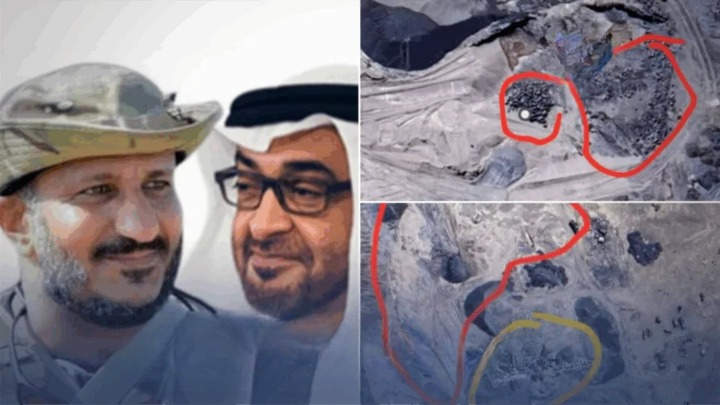A Treasure Beyond Gold… The Emirati Occupation Steals Yemen’s Black Sand to Manufacture Missiles and Aircraft
Natural wealth plundered from Yemen’s subsoil to build the enemy’s arsenal in Abu Dhabi and “Tel Aviv”
In a new scene of the organized plunder practiced by occupying forces and their mercenaries, Yemen’s coasts have for years been the target of one of the largest thefts of natural resources. The Emirati occupation—through its shell companies and traitorous brokers—has been looting huge quantities of black sand rich in rare minerals from areas such as Al-Mokha and Dhu Bab in western Taiz, As-Sufal in Shabwah, Barum Mayfa‘a in Hadhramaut, and even Zaqir Island in Al-Hudaydah governorate, shipping them directly to ports in the UAE. This is a complete looting operation that finances the war machine and supports Western and Zionist military industries.
Black sand… a strategic treasure worth more than gold
Black sand is not merely dark-colored soil, as some might think. It is the natural ore of some of the world’s most valuable and rare minerals—such as titanium, zirconium, vanadium, uranium, and rare earth elements—which are used in making electronic chips, rocket and aircraft engines, nuclear reactors, laser devices, high-energy lighting, superconducting magnets, precision medical technologies, and superconductors.
This immense wealth, which the world competes to control because it underpins modern technology, is being looted in Yemen under the spears of the Emirati occupation, with the cover of its local instruments in the occupied provinces, while the inhabitants of those areas live in dire poverty and without basic services.
From Al-Mokha to Shabwah… the lines of plunder stretch along Yemen’s coast
From western Taiz, where beaches are rich in rare minerals, to the coasts of Shabwah and Hadhramaut, systematic looting operations are carried out by Emirati companies operating under fictitious names such as “Al-Dhafra General Trading” and “Al-Mahra Marine Contracting,” transporting thousands of tons of sand through ports controlled by UAE-backed militias.
In As-Sufal in Shabwah, for example, a ton of black sand is sold to Emirati middlemen for no more than $1,500, while its true price on global markets ranges between $600,000 and $800,000—meaning that every shipment stolen from Yemen’s coasts represents a sovereign loss of hundreds of millions of dollars in favor of Abu Dhabi.
In western Taiz—especially Al-Mokha and Dhu Bab—the looting is carried out without contracts or any legal pretense, under full protection of Tariq Affash’s mercenaries and members of the so-called “Joint Resistance Forces,” in return for scraps of personal commissions paid to militia leaders.
UAE… from promises of reconstruction to resource colonization
The UAE came to Yemen under banners of “the coalition” and “reconstruction,” but it quickly transformed into a real occupying power, managing organized smuggling and plundering networks that are not limited to oil and gas but extend to sand, minerals, marine wealth, and strategic islands.
Reports indicate that a large portion of the looted sand is used in the UAE’s EDGE Group military industries, which produce components for drones and guided missiles—some of which were later supplied to the Zionist entity as part of expanded military and intelligence cooperation deals following the “normalization agreements.”
Thus, stolen Yemeni sand becomes part of the industry of death used against the peoples of the region, in flagrant violation of national sovereignty and international humanitarian law.
A compound crime: economic looting and strategic occupation
The danger of this crime goes beyond resource loss; it also has strategic dimensions. By controlling ports and coasts, the Emirati occupation seeks to consolidate its geopolitical influence over the Red Sea and the Gulf of Aden, turning Yemen into a dependent resource depot serving the interests of Washington and Tel Aviv.
The Emirati presence in Al-Mokha, Dhu Bab, Barum, and Zaqir is not a transient military presence but part of a long-term plan to dismantle Yemen and control its maritime gateways and terrestrial wealth—aligned with an American–Zionist agenda to weaken the axis of resistance and prevent the emergence of a strong, independent Yemeni state.
The Revolutionary Leadership… the voice of sovereignty against looting and colonization
In response to this organized plunder, the revolutionary and political leadership in Sanaa has repeatedly affirmed that all of Yemen’s wealth belongs to the Yemeni people and that the era of pillage and domination is over.
Leader Sayyid Abdul-Malik Badr al-Din al-Houthi has emphasized in more than one speech that “whoever steals Yemen’s wealth will be held accountable for every barrel and every shipment,” asserting that the able Yemeni hand that can strike Tel Aviv and enemy carriers is also capable of liberating every inch of Y

